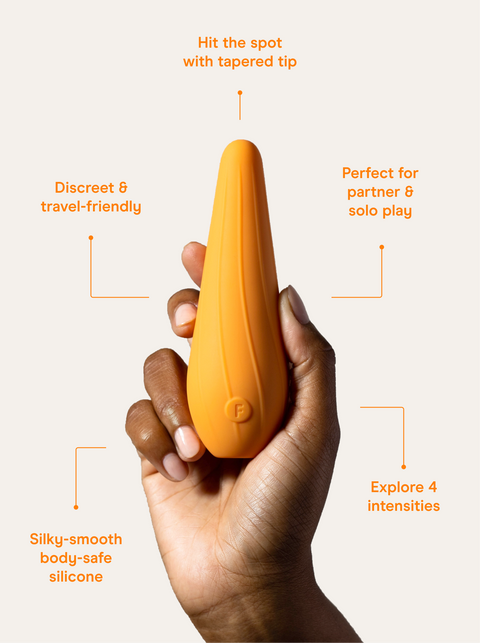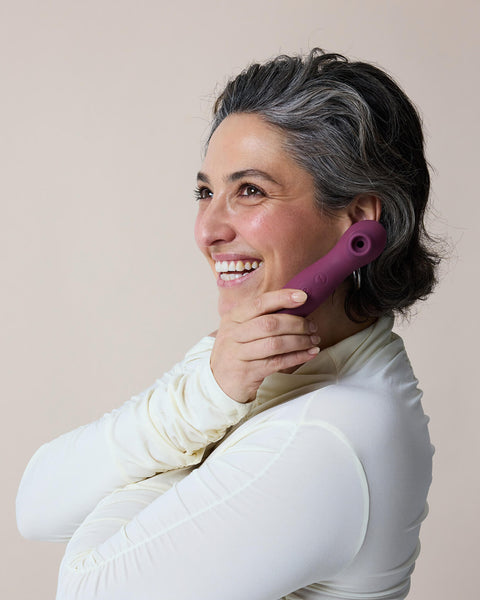If you’re keen to explore BDSM but don’t know where to start—or if you’re just curious to know exactly what people do with those feathered ticklers you see in adult stores—read on!
We’re about to break it down and make BDSM something that you can easily try at home, no Christian Grey vibes necessary.
BDSM stands for bondage, discipline, sadism, and masochism.
These four elements don’t always need to be incorporated into every BDSM-related activity you try—plenty of people enjoy the bondage part but not the sadism bit, for example—but they’re often put together into the broader category of BDSM.
Here’s a deeper look at each:
Bondage
Bondage refers generally to any sexual act that involves being restrained or tied up.
The person being tied up might enjoy allowing their partner to be in control of their pleasure for a while, and the person doing the tying up might enjoy the sense of control they get from being ‘in charge’ of their partner.
It goes without saying that consent is absolutely paramount when restraining a person (more on that in a minute), and that the restraints should always be loose enough that the person being restrained can slip them off if they need to.
Discipline
Discipline refers to a dynamic of punishment and control between two or more people who engage in BDSM.
A person who enjoys surrendering control might allow their partner to ‘train’ them to perform certain acts or ‘discipline’ them for not performing certain acts. Again, consent is key here!
Sadism and Masochism
Sadism and masochism relate to giving and receiving consensual pain.
A person who likes sadism might enjoy inflicting pain on their partner, and a person who enjoys masochism might find it pleasurable to receive pain given by their partner.
Dominance
Dominance and submission are also closely related to BDSM, and involve one partner taking a dominant role over the other partner, who takes a submissive role.
Not everyone who’s into BDSM is automatically dominant or submissive, although a lot of people are. It’s entirely possible to enjoy being both dominant and submissive (which is called being a ‘switch’) or to only enjoy being one or the other.
A word on consent…
As we’ve said so many times before, sex can’t happen without consent, and sexual activity without consent is assault.
Consent is just as important in BDSM as it is in any other type of sexual activity. No matter what kind of activity you’re engaging in—whether it’s spanking, restraint, tickling, or anything else—everyone involved must be consenting at all times.
And although it might feel counterintuitive to ask for consent if you’re in a BDSM situation because there may be a dynamic of dominance and submission, think about it this way: your partner might be submitting to you, but they’re consenting to submit.
You might be whipping your partner or tying them up, but they’re consenting to you doing that. They can withdraw consent at any time, just like you can withdraw consent and say you’d like to stop spanking them or untie them and finish play for the day.
Here’s a great explainer on consent within BDSM, written by someone who regularly hosts orgies—although it does carry a content warning for discussion of assault.
It’s vital to receive ongoing, enthusiastic consent during BDSM play, and here are a few popular ways to do it:
1. Decide on a safe word.
A ‘safe word’ is a word or phrase that you would never ordinarily use in the bedroom, that you and your partner have decided ahead of time works in place of ‘stop’ or ‘no’.
If part of your play involves resisting (or, pretending to resist) to your partner’s actions, you might already be saying, “No, stop!” as part of your dynamic.
But if you suddenly shout, “Pineapple!” or “Lampshade!”, your partner can recognise the safe word as their cue to stop everything immediately, and check in with you to make sure you’re okay.
2. Develop a hand signal or physical sign.
If your mouth is covered, compromised, or even just pressed into the pillow, it may not be practical to use a safe word. Decide ahead of time on a physical signal that means ‘stop’, like two taps on your partner’s thigh or a poke with your toes.
3. Use the ‘traffic light’ system.
‘Red’ means ‘stop immediately’, ‘yellow’ means ‘don’t stop, but don’t go any further’ and ‘green’ means ‘keep going!’.
Make sure you and your partner decide ahead of time on what the traffic light system means for you, so you can use it during your play to check in on each other.
Where to begin?
If you and your partner—or partners—like the idea of playing with some different BDSM dynamics, there are a few ways you can begin.
1. Act out a fantasy.
Together with your partner, choose a fantasy you’ve always wanted to live out and enact it together. Kinky nurse? Sexy masseuse?
Talk about what turns you on and why, and what your hopes are for the fantasy.
See if you can identify any BDSM elements that appeal to you within the dynamic—is the kinky nurse restraining his patient? Does the sexy masseuse punish her client?
Focus on a single element of BDSM and bring it to life in the fantasy you create.
2. Choose some toys together.
With your partner, choose a sex toy or two to use together (or surprise them with a toy if you know them well enough!). Explore elements of control by using the toy on each other and experimenting with how it feels to be in charge of each other’s pleasure.
You can incorporate elements of dominance, submission, and even punishment into this dynamic depending on how it feels to you.
3. Start small.
It’s tempting to go all-out and equip yourself with an armful of paddles, restraints, and blindfolds—but start by focusing on one, small thing and branching out from there.
If your partner’s into spanking, for example, you don’t need to buy an arsenal of whips for your first time. Start slow and use your hand for spanking, and debrief afterwards with your partner. If they loved it, great—you can go a little harder next time.
But it’s always better to be saying, “That was great, let’s do more next time!” than, “That went a bit too far for me.”
Don’t forget the aftercare
Within BDSM, ‘aftercare’ refers to the time you spend with your partner after sex or play. If you’ve just done something particularly intense, both you and your partner might be feeling exhilarated but a bit vulnerable afterwards.
This is often referred to as ‘subdrop’ or ‘domdrop’, named after the emotional ‘drop’ you might experience after submission or domination.
You can counter these feelings with some aftercare, where you can debrief with your partner, snuggle and give each other physical affection, or just chill out and watch TV with some snacks.
It’s bad manners to end sex by immediately rolling over and tuning out at the best of times, but particularly so after BDSM play.
Use this time to be intimate with your partner, check in on them, and make sure you’re both comfortable and happy with how everything went.
To learn more about the foundations of great sex from acclaimed sex coach Georgia Grace, check out NORMAL's online video masterclass The Modern Guide to Sex.




































